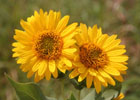
| Coughlen Natural Area
and Kansas Turnpike
James S. Aber
|
Introduction
The Coughlen Natural Area of Emporia State University consists of 44 acres of prairie, wetland, and woodland located adjacent to the Kansas Turnpike (I-35) in southwestern Lyon County. The area is reserved for student research, and the prairie is managed with controlled burning every few years. A small stream crosses the site and a spring provides water year round. The local vicinity is underlain by shale and limestone bedrock.
The Coughlen Natural Area has been modified by human activity in the past. Broad, shallow excavations expose weathered shale, linear furrows resemble bulldozer tracks, a small ridge forms a terrace, and the spring is dug out as a circular pool. When these changes were made is unknown. The spring pool forms a perennial water supply, but the purpose of other modifications is uncertain. Although restored prairie covers the site now, signs of these older features remain conspicuous.
I visited the Coughlen site in late August under relatively mild weather conditions. Mid-day temperature was in the mid-80s with sunny sky and a moderate breeze from the south-southeast. Launch site was the open prairie in the northern portion of the natural area downwind from trees along the stream. The large rokkaku kite was utilized to lift the Canon S70 autoKAP rig as well as the Nikon GPS radio-controlled rig. Both camera rigs worked flawlessly. Wind and sky cooperated until the end of the session when cloud cover moved over the region and wind speed increased.

| Overview of the Coughlen Natural Area. Looking toward the northeast (left) the natural area is in the foreground and the Kansas Turnpike behind. View southward with the natural area in the left foreground (right). A county road bridges over the turnpike in the background, and a small stream marked by trees crosses the southern end of the natural area. Asterisk (*) marks the launch site for kite aerial photography.
|  |

| Close-up shots. Left: Coughlen prairie area in foreground, and cattle grazing in pasture across the road. Right: restored prairie portion of Coughlen area: a) spring pool, b) terrace-like ridge, c) excavated zone with linear tracks.
|  |

| Ground views of Coughlen Natural Area. Left: spring with cattails, watercress, algae, and other wetland vegetation. Right: excavated zone displays bare patches of weathered shale, and a small bank (b) in the background marks the limit of excavation.
|  |



| The restored prairie displayed a variety of grasses, forbs, and wildflowers in bloom, including snow-on-the-mountain (left, Euphorbia marginata, KWG), ashy sunflower (center, Helianthus mollis, KWG), and willow-leaf sunflower (right, Helianthus salicifolius, KWG). Flower identifications by M. Sundberg.
|
Flash flooding
A motorist died on the Kansas Turnpike during a flash flood at this site (mile marker 118) on July 10, 2015. A downpour flooded the drainage ditch along the eastern side of the turnpike creating a temporary lake; the culvert was overwhelmed and water spilled across the turnpike 6-10 inches deep. The car lost control and went into the ditch; the motorist and car were sucked underwater into the culvert of a small stream that drains across the turnpike and into the Coughlen area.

| Looking toward the northeast with Coughlen area in the foreground and Kansas Turnpike behind (left). The asterisk (*) marks the site of the flash flood, culvert, and fatality. Ground view of the flooding site on the Kansas Turpike (right). Temporary lake formed on the east (right) side, and Coughlen Natural Area is on the opposite side.
|  |

| Views looking downstream (left) and upstream (right). Trees mark the course of the unnamed stream that experienced flash flooding on July 10, 2015. Asterisk (*) indicates the culvert where the fatality took place.
| 
|
The 2015 fatal accident took place just two miles north of where a similar event took place in 2003. A flash flood swept several vehicles off the turnpike and six people died, including five members of one family. A dozen years passed since that tragedy, and yet the potential for flash flooding remains.

| Looking along the Kansas Turnpike toward the southwest. Asterisk (*) marks the site of the 2003 flash-flood tragedy near mile marker 116. Seven vehicles were washed off the roadway by Jacobs Creek, and bodies of two victims were recovered two miles downstream (to the right).
|
2016 update
The Kansas Turnpike Authority (KTA) has undertaken major drainage improvements at both flash-flood sites. New, larger culverts are under construction with completion scheduled for autumn 2016. These culverts are designed to handle 100-year-flood runoff. The new culverts are specially configured to allow passage of fish, in particular the Topeka shiner (Notropis topeka), which is a species of minnow. In addition, stream gauges and automatic warning signs were installed to alert drivers immediately when water-level rises in the creeks. The project cost is $2.7 million, paid for with turnpike tolls.
 Related sites
Related sites

Text and images © J.S. and S.W. Aber
 Return to kaphome or gallery.
Return to kaphome or gallery.
Last update: July 2016.




